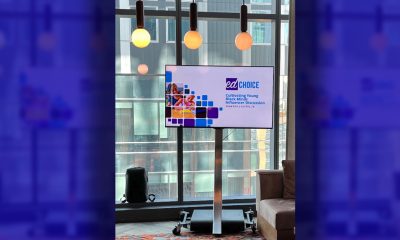#NNPA BlackPress
New visual book relives life and commerce along the Mississippi River
LOUISIANA WEEKLY — The murky, muddy waters of the Mississippi River go on for miles and can be seen treading beneath the many boats and barges that slowly crawl along the river, daily.
Award-winning photographer Richard Sexton spent two decades observing and documenting the river, its industrialization and how it continues to evolve as time goes. This project began as a sponsorship for a portfolio of industrial landscape but later turned into something more.
By Sydney Odom
The murky, muddy waters of the Mississippi River go on for miles and can be seen treading beneath the many boats and barges that slowly crawl along the river, daily.
Award-winning photographer Richard Sexton spent two decades observing and documenting the river, its industrialization and how it continues to evolve as time goes. This project began as a sponsorship for a portfolio of industrial landscape but later turned into something more.
On Sept. 17, the Historic New Orleans Collection (HNOC), a museum and research institute dedicated to the study and preservation of the history and culture of New Orleans, released “Enigmatic Stream: Industrial Landscapes of the Lower Mississippi River,” a book chronicling the impact of industrialization between and along the Mississippi River’s banks over the past 20 years.
“New Orleans is here because of the river. I wanted to showcase that and let people decide what they think about it,” Sexton said.
The book features 100 black-and-white photographs showcasing the changes on and along the river’s bank, as well as how it has been integrated in everyday life. To accompany the release of the book, an exhibit of the images is on display at the HNOC’s exhibition center at 520 Royal St. until April 5, 2020. The exhibit uses some of the photos to highlight the development of the landscape. Both the exhibit and book contextualize the obvious but also complex uses of the Mississippi River.
The photos are organized geographically in the exhibit, starting in St. Bernard Parish and ending in Baton Rouge Parish. The section of the river from Baton Rouge to New Orleans is one of the most economically dominant passages in the country.
“New Orleans is still a prominent city because of the economic development of the river,” Sexton said. The photos bring the river to the forefront and help spark aesthetic and critical discussions about life in the city. They raise debates on issues such as global warming and how industrialization has and is affecting the land and communities around it.
“The exhibit speaks to the changing relationship between humans and the landscape of the lower Mississippi over the last decades,” said Siobhan McKiernan, an associate editor for The Historic New Orleans Collection. The Collection felt it was necessary to display Sexton’s work because of the impact that it could have on understanding the community. The photos speak to the dramatic changes that cannot always be seen by just gazing at the river, McKiernan explained.
New Orleans is a port-city with tons of goods in transit every day. Large corporations take advantage of the easy access that the Mississippi River provides but do not consider the environmental cost that the locals may have to pay, McKiernan explained.
Sexton’s work portrays this through photography of the residential areas along the water. They highlight the growing erosion and depreciation of the land. The images are annotated with essays from author Paul Schneider, who has produced books on natural history, and John H. Lawrence, who contextualized Sexton’s images.
“A lot of people aren’t aware of the history of the river in Louisiana,” said Jenny Bagert, a resident who attended the exhibit launch on Sept. 17. The exhibit along with the book display the current history of the Mississippi River, one that is rarely shown to the public. Bagert added that she felt the images clearly show the evolution of southeastern Louisiana that residents do not normally get to see.
While many public conversations surround changes to the city’s more touristic parts, residents who attended the exhibit launch said there is a need for more documentation that reflects social and environmental changes that impact ordinary residents. Presenting Sexton’s photos in the Historic New Orleans Collection provided them a place for a conversation about the environment that is playing out in activism and policy making, particularly during disasters.
The exhibition and book not only seek to present information but also inspire change, residents said. “This has really been a wakeup call for me,” Bagert said.
“Enigmatic Stream” is available for purchase at The Shop at The Collection. Admission to the exhibition is free. Both the museum and the shop are open to the public Tuesday-Saturday from 9:30 a.m. to 4:30 p.m. and Sunday from 10:30 a.m. to 4:30 p.m. More information about the book, exhibit and HNOC online at www.hnoc.org.
This article originally published in the October 14, 2019 print edition of The Louisiana Weekly newspaper.
This article originally appeared in The Louisiana Weekly.
#NNPA BlackPress
LIVE! — ASK ALMA — TUES. 5.30.23 7PM EST
This week, guest host Leah Farmer King and her panel share tips and advice to reader mail. Leah and the panel, along with the …
The post LIVE! — ASK ALMA — TUES. 5.30.23 7PM EST first appeared on BlackPressUSA.

This week, guest host Leah Farmer King and her panel share tips and advice to reader mail. Leah and the panel, along with the …
The post LIVE! — ASK ALMA — TUES. 5.30.23 7PM EST first appeared on BlackPressUSA.
#NNPA BlackPress
LIVE! — ASK ALMA! — TUES. 1.9.24 7 PM EST
HAPPY NEW YEAR! Welcome back for our first show of the year! This week, Alma and her panel answer viewer mail. As always …
The post LIVE! — ASK ALMA! — TUES. 1.9.24 7 PM EST first appeared on BlackPressUSA.

HAPPY NEW YEAR! Welcome back for our first show of the year! This week, Alma and her panel answer viewer mail. As always …
The post LIVE! — ASK ALMA! — TUES. 1.9.24 7 PM EST first appeared on BlackPressUSA.
#NNPA BlackPress
LIVE! — ASK ALMA! — TUES. 1.30.24 7PM EST
Think you’re the only one with problems? Each week, NNPA advice columnist Alma Gill, along with her panel of guest advisors …
The post LIVE! — ASK ALMA! — TUES. 1.30.24 7PM EST first appeared on BlackPressUSA.

Think you’re the only one with problems? Each week, NNPA advice columnist Alma Gill, along with her panel of guest advisors …
The post LIVE! — ASK ALMA! — TUES. 1.30.24 7PM EST first appeared on BlackPressUSA.
-

 Community3 weeks ago
Community3 weeks agoFinancial Assistance Bill for Descendants of Enslaved Persons to Help Them Purchase, Own, or Maintain a Home
-

 Business3 weeks ago
Business3 weeks agoV.P. Kamala Harris: Americans With Criminal Records Will Soon Be Eligible for SBA Loans
-

 Activism3 weeks ago
Activism3 weeks agoOakland Post: Week of April 10 – 16, 2024
-

 Community3 weeks ago
Community3 weeks agoAG Bonta Says Oakland School Leaders Should Comply with State Laws to Avoid ‘Disparate Harm’ When Closing or Merging Schools
-

 Community2 weeks ago
Community2 weeks agoRichmond Nonprofit Helps Ex-Felons Get Back on Their Feet
-

 Community2 weeks ago
Community2 weeks agoOakland WNBA Player to be Inducted Into Hall of Fame
-

 Activism1 week ago
Activism1 week agoOakland Post: Week of April 24 – 30, 2024
-

 Community2 weeks ago
Community2 weeks agoRPAL to Rename Technology Center for Retired Police Captain Arthur Lee Johnson






















































